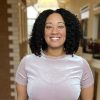This article is more than 5 years old.
Two weeks ago I attended The Library Diversity and Residency Studies Conference held in Greensboro on August 26-27, 2019. The two-day conference was hosted by UNCG in collaboration with ASERL and the ACRL Diversity Alliance.. The focus of the conference was on Diversity, Equity, and Inclusion in libraries, further concentrating on Library Diversity Residency programs. The overall conference was inviting and I was honestly surprised at the number of attendees and presenters who traveled from other parts of the country. There were three keynote speeches and several panel sessions spread across two days; luckily, I wasn’t put in a position that made me choose between panels.
The opening keynote was delivered by Deena Hayes-Green of the Racial Equity Institute (REI). Using information from the REI’s report on the Groundwater Approach, Hayes-Green used toxic groundwater as a metaphor for systemic racism and how that explains the impact racism has, not just on individuals, but across different systems (education, health, welfare…). Building on that, she introduced the concept of “markedness” as a result of systemic racism. Markedness says that the unmarked member of any pair is the most usual, which further implies that labeling the other member makes that thing unusual by default (i.e. minority institutions – “Latino credit union”, “Black church”, “Historically Black College”). This concept really resonated with me and overall, it was a great keynote because it addressed some overarching feelings of sustainability regarding diversity programs. Are these programs being managed in a way that is actually making the profession more diverse, equitable, and inclusive by setting participants up for continued success? The full list of panel sessions is listed below
- Session 1– Equity Diversity & Inclusion in Librarianship
- Session 2 – Best Practices in Establishing Library Diversity Residency Programs
- Session 3 – New to Profession, but Not a New Professional
- Session 4 – Diversity in Librarianship .
- Session 5 – Diversity, Inclusion and Social Justice
- Session 6 – Mentorship, Equity, Diversity, & Inclusion
- Session 7 – Diversity and Inclusion Initiatives that Focus on Student Success
- Session 8 – Library Diversity and Residency Studies
Topics and ideas that I found interesting included, but certainly were not limited to, establishing best practices and implementation for a diversity residency and strengthening the diversity pipeline in librarianship. Some key points offered by best practice presentations addressed fair compensation, work, and transparency for both residents and all levels of library employees. A fact that was presented in several presentations was the importance of having a good mentor for residents and fellows. Jason Alston’s research with feedback from residency participants identified strong mentorship as a contributing factor towards their success in the program. Additionally, Twanna Hodge and Kelsa Bartley also presented on the impact of mentorship on recruitment and retention among librarians from underrepresented groups. They also provided information for building a network beyond a program or single organization.
I really enjoyed hearing about the work being done at William & Mary through their Mosaic Diversity Program. The program is for students and recent graduates interested in library careers. The internship is for undergraduates and the one-year fellowship program is for recent graduates from any 4-year college or university in Virginia, which is nice because Virginia does not have any school with an ALA-accredited MLS program. The fellowship program does not require that applicants have prior experience working in a library and fellows are given a stipend for graduate school applications and any further assistance they might need with the application process. A somewhat similar approach to support was presented by the University of Oregon. When residents are close to finishing their three-year program they are given time and support to look for and apply to jobs (this included any time off needed for the interview process.).
At the end of day 2, remaining attendees were asked to join “Birds of a Feather” groups to continue discussions in areas of interest such as starting a program, best practices, and anything else regarding diversity residency programs by either sharing or gaining insight from other institutions. Many organizations were getting started by establishing Inclusion committees, or laying the groundwork for a residency. I was not surprised at the amount of planning needed to establish a fellowship or program, however, I’m glad that this conference addressed the many considerations that need to be made before moving forward. For a two-day conference there was a lot to take in and think about, if anyone is interested in hearing more about what was covered or the other keynotes, I’d love to share!

3 Comments on ‘Ashelee @ LDRS’
That’s so great that you went to a local conference that had so many attendees from all over the country. I’m sure it was great comparing everyone’s experiences.
All these presentations sound very applicable to many kinds of activities – so nice to not have to choose between them. Thanks for attending and reporting back!
This sounds fantastic. I’ll have to hear more next time we catch up! 🙂